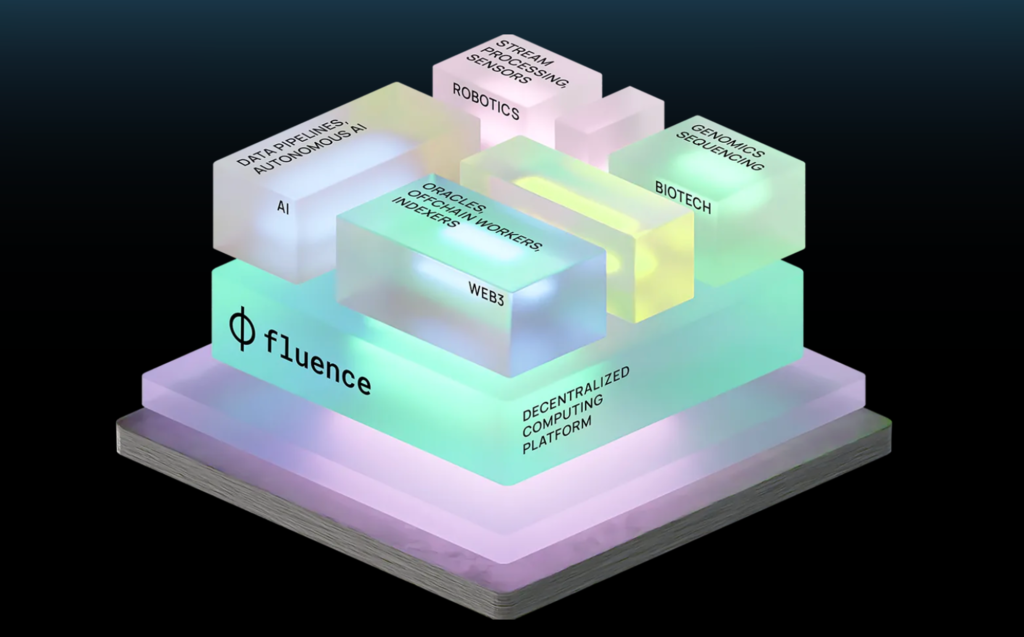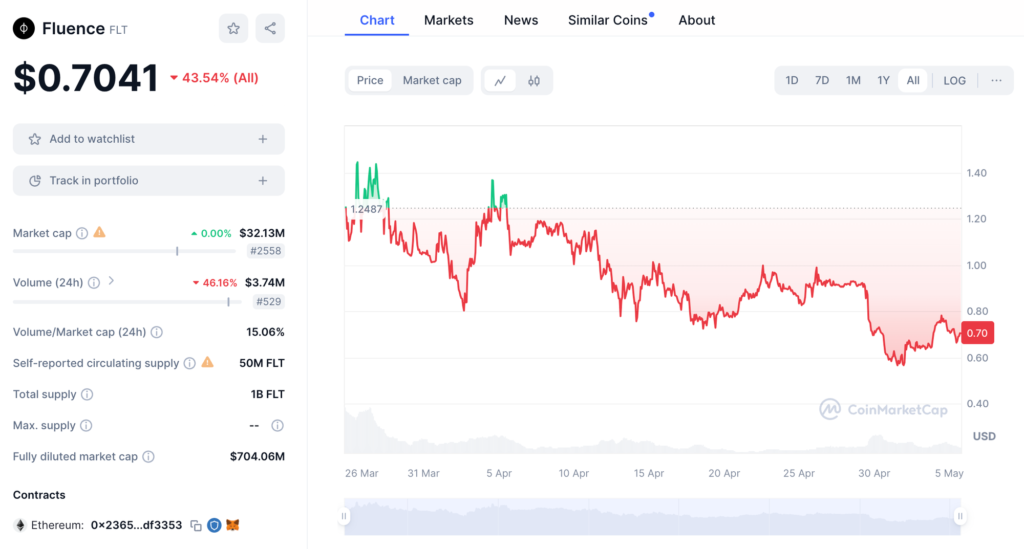Fluence (FLT): A Decentralized “Cloudless” Computing Platform

Recently, there has been significant buzz in the crypto community surrounding narratives like DePIN, AI, and Decentralized Cloud Network (DCN). These three have the potential to introduce innovative applications across various sectors like the Internet of Things (IoT), smart cities, decentralized financial , scientific calculations, and more. Fluence emerges as a crypto project that integrates these narratives. In this article, we’ll dive deeper into what Fluence is, how it works, and its potential in the future.
Article Summary
- 🏗️ Fluence is a DePIN (decentralized physical infrastructure network) platform that provides an open and low-cost alternative to traditional cloud computing. This means that Fluence does not rely on centralized servers.
- 🤖 Fluence aims to drive innovation by offering affordable, verifiable, and accessible computing. It is important for the Web3, AI, IoT, and science sectors.
- ☁️ Fluence is building a decentralized computing platform through its Developer Platform and Compute Marketplace. The Developer Platform offers a serverless experience using Wasm and Aqua. Meanwhile, the Compute Marketplace allows computing providers to create bids, set prices, and conduct transactions.
- 🪙 FLT (ERC-20) is Fluence’s utility token and governance token. The platform uses the Fluence token for transactions within its ecosystem.
What is Fluence (FLT)?
Fluence is a decentralized computing platform that provides an open, low-cost alternative to traditional cloud computing. It does not rely on centralized servers. Instead, it harnesses the power of decentralization through a network of nodes spread across the globe.
This platform combines CPU resources from top-tier data centers worldwide in the global, resilient, always-on DePIN platform. The platform enables other companies to transition to a cloudless system to avoid subjective censorship and data lock-in.
Learn more about what DePIN is in this article.
The platform aims to provide efficient and secure data processing for various applications on Web3. As such, Fluence empowers developers to build and deploy applications without relying on centralized servers to foster a more open and inclusive digital ecosystem through the Developer Platform.
For users, you can participate as computing providers in Fluence’s Compute Marketplace (currently under development on the private testnet) to earn rewards by offering the capacity of any device connected to the network. These devices can range from professional rigs to personal laptops. Setting up is straightforward since the Fluence protocol establishes the reliability system.
Fluence enables important uses in providing decentralized and verified computing, especially for proving AI engine training on specific data and executing queries without manipulation. This offers an open and decentralized AI model and ensures transparent results.
Who founded Fluence (FLT)?
Fluence was founded by Tom Trowbridge, Evgeny Ponomarev, and Dmitry Kurinskiy in 2017. Prior to his involvement with Fluence Labs, Tom was the co-founder and President of Hedera Hashgraph , a leading project in the blockchain industry.
In February 2022, Fluence successfully secured a $9 million Series A funding round led by Multicoin Capital, along with Protocol Labs, Arweave, Peer VC, and other investors. Since its establishment in 2017, Fluence Labs has raised $15 million. Early backers include 1kx, Blockchange Ventures, Dekrypt, Distributed Global, and Inblockchain.
How does Fluence (FLT) work?

Fluence creates a secure, efficient, and permissionless decentralized computing network. It utilizes Aqua, a new programming language for p2p applications and protocols, and Marine, a lightweight and fast web assembly runtime.
To run the infrastructure, this platform operates through several main components, which are as follows:
- Fluence Protocol: This protocol forms a computing resource network and establishes a cloudless stack for compute execution.
- Proof of Compute: The Fluence protocol ensures the creation of cryptographic proofs for all executions within the network to ensure the validity of work paid for by customers.
- Marketplace: The Fluence marketplace facilitates connections between compute providers and customers. Customers can select providers based on price and other parameters.
- Proof of Capacity: Fluence uses cryptographic proof to ensure that the resources advertised by computing providers exist. This ensures that customers get what they pay for.
- Resource Pricing: Customers pay in advance based on rental time. Fluence plans to introduce on-demand billing models in the future.
- Networking: The Fluence network consists of interconnected nodes spread across the globe. These nodes are involved in various economic activities, including monitoring agreements, forming subnets, deploying applications, and handling requests. Moreover, they generate proof of execution to maintain system reliability.
What are the advantages of Fluence?
Fluence offers a unique decentralized computing solution with several key advantages:
- Decentralized Serverless: Fluence is pioneering the development of a decentralized serverless solution by combining the advantages of serverless with the benefits of decentralization.
- CPU Capacity Utilization: This platform aggregates CPU capacity from top-tier data centers worldwide, making it possible to operate different types of applications on CPUs.
- Reliability and Resiliency: This platform ensures reliability with always-on subnets by providing load balancing, failover, and fault tolerance algorithms.
- Auditability and Security: It provides a verified and secure solution with cryptographic proofs for all computations.
- Robust Development Stack: It offers a flexible development stack, enabling developers to run computations across various cloudless infrastructures.
- Low Cost: By encouraging competition and providing FLT rewards, this platform reduces computing costs significantly compared to centralized platforms.
FLT Token as an Investment
FLT serves as Fluence’s utility and governance token. It incentivizes computing providers and verifies computing tasks. Computing providers who stake FLT tokens receive rewards in FLT and stablecoin payments for their computational efforts.
FLT holders can also propose and vote on governance proposals using their tokens on the Fluence DAO. Proposals can include treasury management, protocol improvements, and partnerships with other parties.

FLT launched on the Ethereum mainnet in early March 2024 with a total supply of 1 billion tokens. By May 5, 2024, approximately 50 million FLT tokens were circulated. FLT is currently valued at $0.70, with a market capitalization of $32.13 million, positioning it at number 2,558 on Coinmarketcap due to its relatively small market cap.
Due to its small market cap, Fluence is considered a ‘hidden gem’ project for its potential and technology. Fluence’s infrastructure has a wide range of functions, such as the development of the AI sector, fault-tolerant data management in IoT (Internet of Things), DeFi automation and blockchain RPC in Web3 and real-time data processing in science and biotech.
In addition, this platform is working with Filecoin and InterPlanetary Consensus (IPC) to strengthen advanced cloudless computing. Fluence utilizes Filecoin’s smart storage for data storage. On the other hand, IPC provides this platform with advanced cryptographic proof verification capabilities, namely zero-knowledge proof verification (ZKP) such as Proof of Capacity.
Fluence leverages competition among computing providers and FLT rewards to substantially reduce computing prices compared to centralized platforms. This cost-effectiveness makes it appealing to enterprises and individuals aiming to streamline their computing expenses.
Conclusion
Fluence is a decentralized computing platform that does not rely on a centralized cloud infrastructure. By pooling global CPU resources, it facilitates the efficient and secure operation of various Web3 applications. Its key advantages include decentralized serverless architecture, robust infrastructure reliability, and cost-effectiveness.
With its partnerships with Filecoin and IPC, Fluence enhances cloudless computing infrastructure, providing cost-effective solutions for users seeking decentralized computing technology. This offers promising investment opportunities for those interested in participating in the advancement of computing infrastructure.
Buy FLT Token on the Pintu App
On Pintu, you can buy FLT and other tokens such as HNT, FIL, RNDR, and LPT without worrying about fraud. In addition, all crypto assets on Pintu have passed a rigorous assessment process and prioritize the principle of prudence.
The Pintu application facilitates transactions by being compatible with various popular digital wallets, such as Metamask. Download the Pintu app on the Play Store and App Store! Your safety is guaranteed because Pintu is regulated and supervised by Bappebti and Kominfo.
In addition to making transactions on the Pintu app, you can learn more about crypto through various Pintu Academy articles that are updated weekly! All Pintu Academy articles are created for educational and knowledge purposes, not as financial advice.
References
- Fluence Team, What is Fluence, Docs, accessed 1 May 2024.
- The Fluence DAO, The Future is Cloudless: Fluence’s DePIN computing platform DAO and FLT token are now live, Blog, accessed 1 May 2024.
- The Fluence DAO, Go Cloudless: 6 Reasons to Build with Fluence, Blog, accessed 1 May 2024.
- Evgeny Ponomarev, $9 million Series A led by Multicoin Capital, Medium, accessed 2 May 2024.
Share
Related Article
See Assets in This Article
HBAR Price (24 Hours)
Market Capitalization
-
Global Volume (24 Hours)
-
Circulating Supply
-


